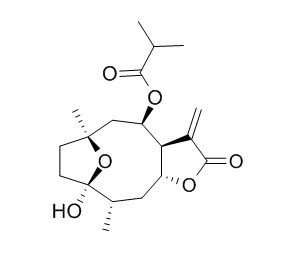Tirotundin
Tirotundin is a PPARα/γ dual agonist, it exerts anti-diabetic effect through PPARγ pathway. It shows anti-inflammatory activity, it inhibits inhibit the activation of NF-kappa B, thereby, the synthesis of inflammatory mediators such as cytokines and chemokines is reduced.
Inquire / Order:
manager@chemfaces.com
Technical Inquiries:
service@chemfaces.com
Tel:
+86-27-84237783
Fax:
+86-27-84254680
Address:
1 Building, No. 83, CheCheng Rd., Wuhan Economic and Technological Development Zone, Wuhan, Hubei 430056, PRC
Providing storage is as stated on the product vial and the vial is kept tightly sealed, the product can be stored for up to
24 months(2-8C).
Wherever possible, you should prepare and use solutions on the same day. However, if you need to make up stock solutions in advance, we recommend that you store the solution as aliquots in tightly sealed vials at -20C. Generally, these will be useable for up to two weeks. Before use, and prior to opening the vial we recommend that you allow your product to equilibrate to room temperature for at least 1 hour.
Need more advice on solubility, usage and handling? Please email to: service@chemfaces.com
The packaging of the product may have turned upside down during transportation, resulting in the natural compounds adhering to the neck or cap of the vial. take the vial out of its packaging and gently shake to let the compounds fall to the bottom of the vial. for liquid products, centrifuge at 200-500 RPM to gather the liquid at the bottom of the vial. try to avoid loss or contamination during handling.
Int J Mol Sci.2019, 20(11):E2734
Molecules.2019, 24(12):E2286
Chem Res Toxicol.2023, 36(2):213-229.
Biochem Biophys Res Commun.2021, 534:802-807.
Int J Mol Sci.2021, 22(19):10220.
J Agric Food Chem.2020, 68(51):15164-15175
Plant Cell Physiol.2018, 59(1):128-141
Sci Rep.2023, 13(1):14594.
Mol Med Rep.2022, 26(4):299.
Toxicol In Vitro.2022, 81:105346.
Related and Featured Products
Planta Med. 1998 Oct;64(7):588-93.
Study of three sesquiterpene lactones from Tithonia diversifolia on their anti-inflammatory activity using the transcription factor NF-kappa B and enzymes of the arachidonic acid pathway as targets.[Pubmed:
9810261]
In Central America leaf extracts from the Asteraceae Tithonia diversifolia are used externally for the treatment of haematomas and wounds. Therefore, the main sesquiterpene lactones (Sls) of this species growing in Costa Rica, diversifolin (1), diversifolin methyl ether (2), and Tirotundin (3), were studied for their anti-inflammatory activity.
METHODS AND RESULTS:
We determined whether these compounds inhibit cyclooxygenase-I, phospholipase A2, or the transcription factor NF-kappa B. Here we show that these Sls do not influence the enzymes of the arachidonic acid pathway, but inhibit the activation of NF-kappa B. Thereby, the synthesis of inflammatory mediators such as cytokines and chemokines is reduced.
CONCLUSIONS:
Our results indicate that the inhibitory activity of compounds 1-3 is due to alkylation of cysteine residues, which are probably located in the DNA binding domain of NF-kappa B. The Sls were also studied for their antibacterial activity, but only Sl 1 was moderately active against Bacillus subtilis in the agar plate diffusion test.
Bioorg Med Chem Lett. 2012 Apr 15;22(8):2954-8.
Sesquiterpene lactones from Tithonia diversifolia act as peroxisome proliferator-activated receptor agonists.[Pubmed:
22424975]
Sesquiterpene lactones, Tirotundin and tagitinin A, were isolated from T. diversifolia and evaluated for their activity against PPARs by the transient transfection reporter assay.
METHODS AND RESULTS:
Tirotundin and tagitinin A transactivated PPARγ dependent promoters including PPRE (PPARγ response element), SHP, and ABCA1 gene promoters in dose-dependent manner. Furthermore, the fluorescence polarization competitive binding assay showed that Tirotundin (IC(50)=27 μM) and tagitinin A (IC(50)=55 μM) enhanced PPARγ transactivation activity by directly binding to PPARγ ligand binding domain. Additionally, they stimulated the transactivation of PPARα dependent SULT2A1 gene promoter by 2.3-fold of vehicle effect at 10 μM.
CONCLUSIONS:
These results highly indicated that Tirotundin and tagitinin A are the active components of T. diversifolia to exert anti-diabetic effect through PPARγ pathway. Moreover, these sesquiterpene lactones behaved as PPARα/γ dual agonists so they might be useful as the potential herbal treatment for diabetes.



